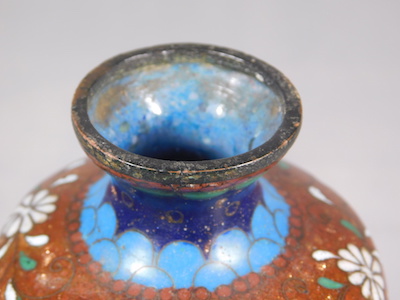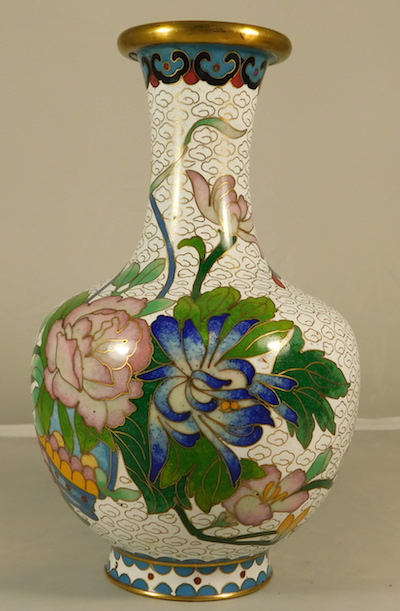The Chinese have also been making fine cloisonne for many centuries. As a result it can at times be difficult to be sure for a particular object whether it comes from China or Japan. This next vase has a simple but attractive spiral design and is fairly certainly of relatively early Japanese make.
What identifies it as Japanese? One obvious area to look at is the area at the top of the neck. This has to be physically strong and so tends to use well proven patterns of wire. The structure here (image ref 6.3) has a line of small circles (red) and then a pattern of semicircles (green) that on some vases overlap like fishscales. We will see this combination repeatedly on Japanese vases we look at, and far less frequently on Chinese vases.
The second image (ref 6.4) shows the enamel inside the mouth of the vase which is often of this shade and texture (and often pale green rather than blue) inside a Japanese vase of this era. Chinese vases often have a smoother more finished appearance.
In practical terms often we can most easily tell that a vase is Chinese cloisonne simply by looking for a pattern at the neck or elsewhere like that below. This ‘RuYi’ pattern, here in dark blue against light blue with a red dot, is very symbolic and so very common.
Notice also the golden wire ‘cloud’ pattern used across the blank spaces on the Chinese vase. That is one of the wiring patterns most commonly used by Chinese vases of that era to keep their strength in otherwise blank areas. The Japanese pattern used for strength wiring is more typically the ‘spiral’ one seen below in images from this vase and from that of object 4.
The base of the vase is another area to look. Again this vase has a combination of a circle of red dots and then a semicircular fishscale pattern. It also has a simple all metal base typical of the era. On Chinese vases the base more commonly has a base of enamel within a metal ring.
Now there are many more indications of origin, but this discussion has covered enough for the moment. Be careful though, there are exceptions to every one of these rules. For example, the spiral patterns became quite fashionable in both countries long after they were needed to strengthen the enamel and were freely added as a decoration by some Chinese designers.
Object 6. Vase height 13.8 cm, weight 126 gm.
_ _ _ _ _ _ _ _ _ _ _ _ _ _ _ _ _ _ _ _ _ _









